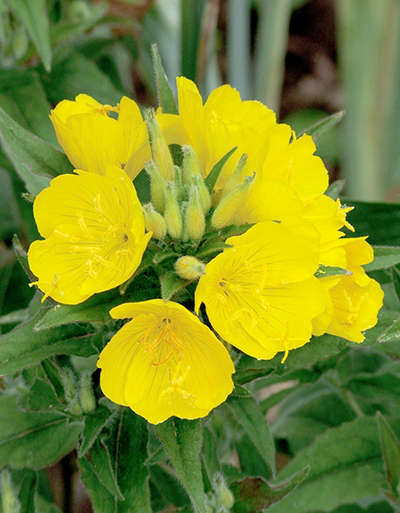
Melondy Phillips
Staff Writer
The back yard bursts with bright yellow flowers displaying their beauty atop tall green stalks and gently swaying in the wind. But these beautiful flowers are not just for looks.
Evening primrose is native to eastern and central North America and comes in many varieties and colors. The constituents of each variety are similar enough that, for the most part, they can be used interchangeably. Mat-thew Wood, a practicing herbalist of more than 40 years and an internationally known teacher and author, says he associates this herb with a rare class of medicines called balsams. Other herbs of this class include Lemon Balm and St. John’s Wort.
The whole plant is usable – roots, stems, leaves, flowers, and seeds – with each part having its own strength and applications.
Evening primrose is a biennial which means it normally takes two years to mature and produce seeds. During the second year of growth, the stalks, leaves, flowers and seeds may be harvested, while the roots are best harvested in the first year. Energy and nutrients stored in the roots are expended the second year as it sends up its seed stalk. This leaves the root devoid of nutrients.
The approximately two-inch in diameter, four-petaled flowers bloom in an array of colors, including pink, white, lavender and yellow.
Several studies involving evening primrose’s medicinal uses revolve around women’s monthly concerns and menopause; however, the applications of this delightful wildflower could encompass everyone.
A whole plant tincture (flower, bud, seedpods, leaf and root) can be used on infected wounds, venomous insect bites and stings, and even some rashes.
Native Americans made poultices from the evening primrose plant for bruises and wounds and used its stem and leaf juices as topical remedies for skin inflammation. A poultice can be applied to bruises or rubbed onto muscles to improve strength.
Evening Primrose oil became a popular folk remedy earning the plant one of its common names, King’s Cure-All.
The oil, which is extracted from the seeds, contains linoleic acid, gammalinolenic acid (GLA), and other omega-6 fatty acids. Most of the studies focus on the GLA itself, instead of the primrose directly.
How it works is not fully understood, however the oil appears to show positive results for skin conditions and inflammation as well as many other promising results.
Many women who suffer with endometriosis, severe PMS, or PCOS (Polycystic ovary syndrome) have been found to have lower levels of GLA. Increasing levels of GLA, through the use of evening primrose oil, appears to help stimulate serotonin production, which could balance out the blues during a woman’s monthly cycle. It may also help ease the symptom of monthly cycles and reduce night sweats and hot flashes during menopause.
A 12-month study conducted on the oil shows that it may be effective at improving cyclic breast mastalgia.
Other conditions that evening primrose may help with are: atopic dermatitis (a type of eczema), rheumatoid arthritis, spasmodic cough, asthma, belly distress of varying kinds and causes, joint/muscle pain, all sorts of wounds, and has the potential to increase the effectiveness of the HIV medication lopinavir.
The following are suggested dosages for different forms of evening primrose: whole plant tincture is 1 to 15 drops up to 3 or 4 times per day, whole plant infusion is 1 to 3 teaspoons dried herb per cup per day, up to 1 tablespoon of ground root or plant in honey as needed, and 1 to 2 tablespoons of ground seed mixed with flaxseed oil per day.
Evening primrose oil is likely safe for most people when taken in doses up to 6 grams daily for up to one year. Mild side effects such as an upset stomach, diarrhea, nausea and headaches are possible.
There may be drug-herb interactions with some medications so caution is suggested. One example of this is that evening primrose may raise the risk of bleeding in people who take antiplatelet and anticoagulant medications.
The Mayo Clinic also recommends against using evening primrose oil if you have a seizure disorder, mania, or are pregnant or breastfeeding.
In addition to the medicinal aspects of evening primrose, many people through- out history have used it as a food source.
The stalks of evening primrose are cut and peeled for a slightly spicy, crunchy vegetable.
The taproots are a little like carrots or parsnips, but with its own flavor. Some describe peeled raw evening primrose root as being mild and sweet, like jicama or parsnip, and “not spicy at all but with a nice sweetness.” Another opinion about its flavor, in Sam Thayer’s book, The Forager’s Harvest, states they’re spicy, and give a burning sensation at the back of the throat when eaten raw. Sam suggests cooking it with several changes of water. He also notes that they taste very different when grown in different locations and environments.
The seeds can be eaten raw or cooked, having a slightly nutty flavor. One way to use them is as a substitute for poppy seeds in muffins.
With that, I’ll leave you with a Native American proverb: “May your life be like a wildflower, growing freely in the beauty and joy of each day.”


